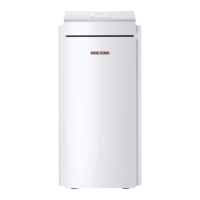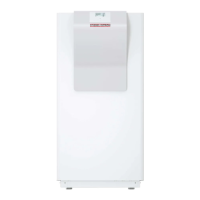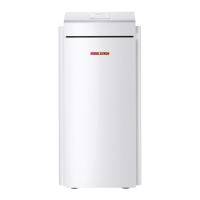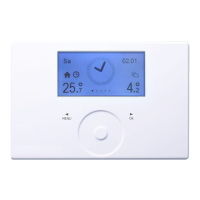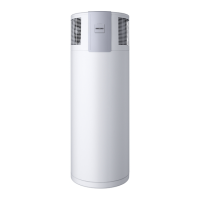22 |
12.3 Initial start-up
12.3.1 Heating curve adjustment
The efficiency of a heat pump decreases as the flow temperature
rises. The heating curve should therefore be adjusted with care.
Heating curves that are set too high cause the zone valves or ther-
mostatic valves to close, which may lead to the minimum flow rate
required for the heating circuit not being achieved.
Observe the instructions for the WPM.
The following steps will help you to adjust the heating curve cor-
rectly:
- Fully open thermostatic or zone valves in a lead room (e.g.
living room and bathroom).
We do not recommend installing thermostatic or zone valves
in the lead room. Control the temperature for these rooms
via a remote control.
- At different outside temperatures (e.g. –10°C and +10°C),
adjust the heating curve so that the required temperature is
set in the lead room.
Standard values to begin with:
Heating curve 0.4 0.8
Control response time 25 50
Comfort temperature 21°C 23°C
If the room temperature is too low in spring and autumn (ap-
prox. 10°C outside temperature), go to heat pump manager menu
SETTINGS / HEATING / HEATING CIRCUIT and raise the parameter
COMFORT TEMPERATURE”.
Note
If no remote control is installed, raising the "COMFORT
TEMPERATURE" parameter will lead to a parallel offset
of the heating curve.
If the room temperature is too low at low outside temperatures,
increase parameter "HEATING CURVE".
If the "HEATING CURVE" parameter has been raised and outside
temperatures relatively high, adjust the zone valve or thermostatic
valve in the lead room to the required temperature.
!
Material losses
Never reduce the temperature in the entire building by
closing all zone or thermostatic valves; instead use the
setback programs.
When everything has been implemented correctly, the system
can be heated to its maximum operating temperature and vented
once again.
!
Material losses
For underfloor heating systems, observe the maximum
permissible system temperature for that particular un-
derfloor heating.
12.3.2 Other settings
For operation with or without a buffer cylinder, observe the
information in the instructions for the WPM and param-
eter BUFFER OPERATION in menu SETTINGS/ STANDARD
SETTING.
Using the heat-up program
If you use the heat-up program, make the following settings on
the WPM:
Initially set the "DUAL MODE TEMP HZG" parameter to 30°C.
Then set the "LOWER APP LIMIT HZG" parameter to 30°C.
Note
After completing the heat-up process, reset the "DUAL
MODE TEMP HZG" and "LOWER APPLIMIT HZG" parame-
ters to their respective standard values or to the respec-
tive system values.
12.4 Appliance handover
Explain the appliance function to users and familiarise them with
its operation.
Note
Hand over these operating and installation instructions
to users for safekeeping.
All information in these instructions must be closely ob-
served. The instructions provide information on safety,
operation, installation and maintenance of the appliance.
13. Settings
13.1 Silent mode
SILENT MODE is an operating mode for air source heat pumps in
which the sound level of the heat pump is reduced.
See the data table (see chapter “Specification/ Data table”)
for the sound power level when silent mode is deactivated.
You can reduce the fan speed and compressor output for a certain
time in the “COMMISSIONING/ SILENT MODE/ OUTPUTREDUC-
TION” menu.
Note
If you activate SILENT MODE, the maximum output at A-7/
W35 is reduced to 70% as standard.
This value can be increased further or reduced to the
specified minimum value as required.
Note
When silent mode is active, operating costs will be higher.
In silent mode 2, heating and DHW heating are provided
solely via the emergency/booster heater.
See the table for the maximum appliance sound levels ac-
cording to the settings made in the “COMMISSIONING/ SI-
LENT MODE/ OUTPUTREDUCTION/ OUTPUT” menu.

